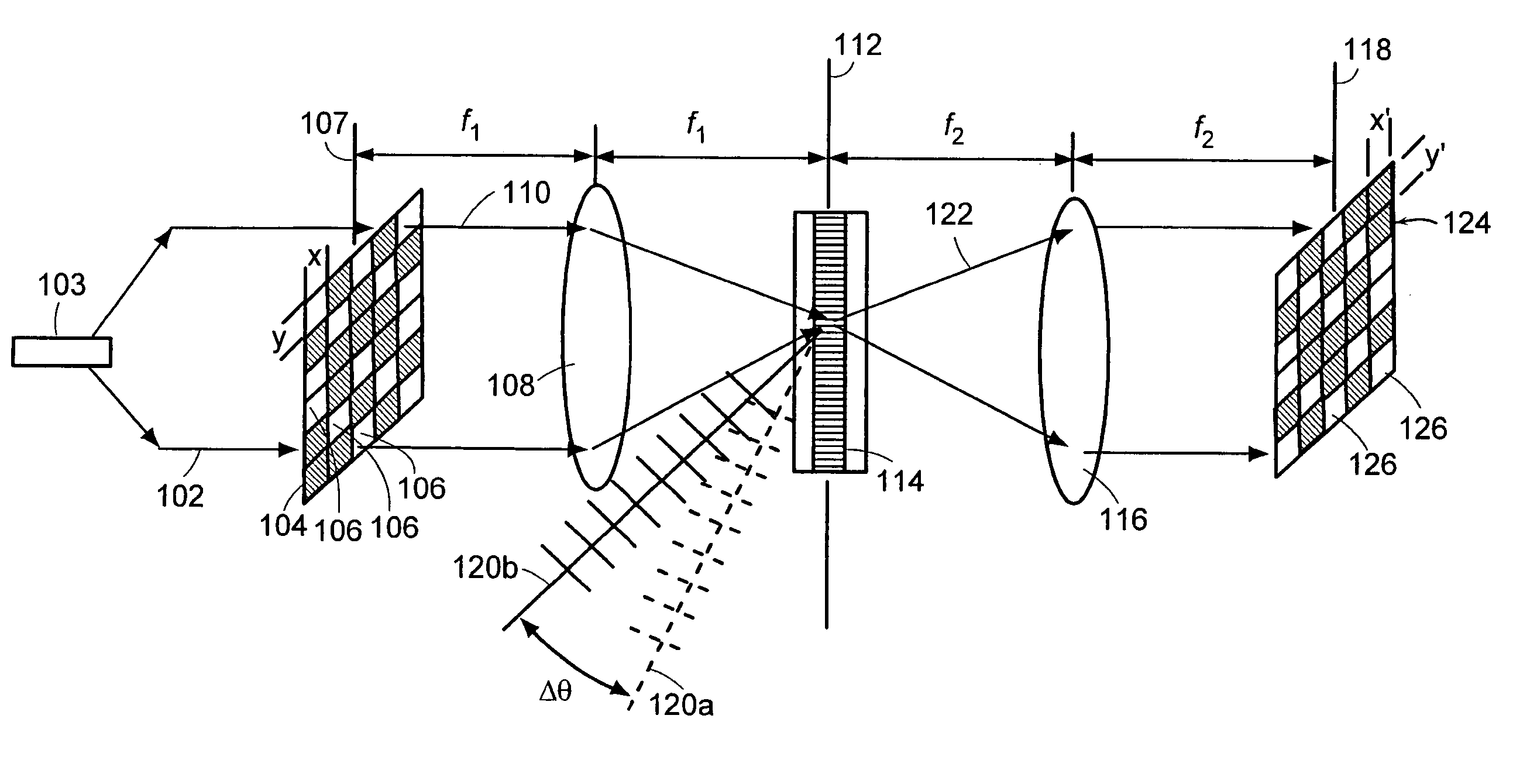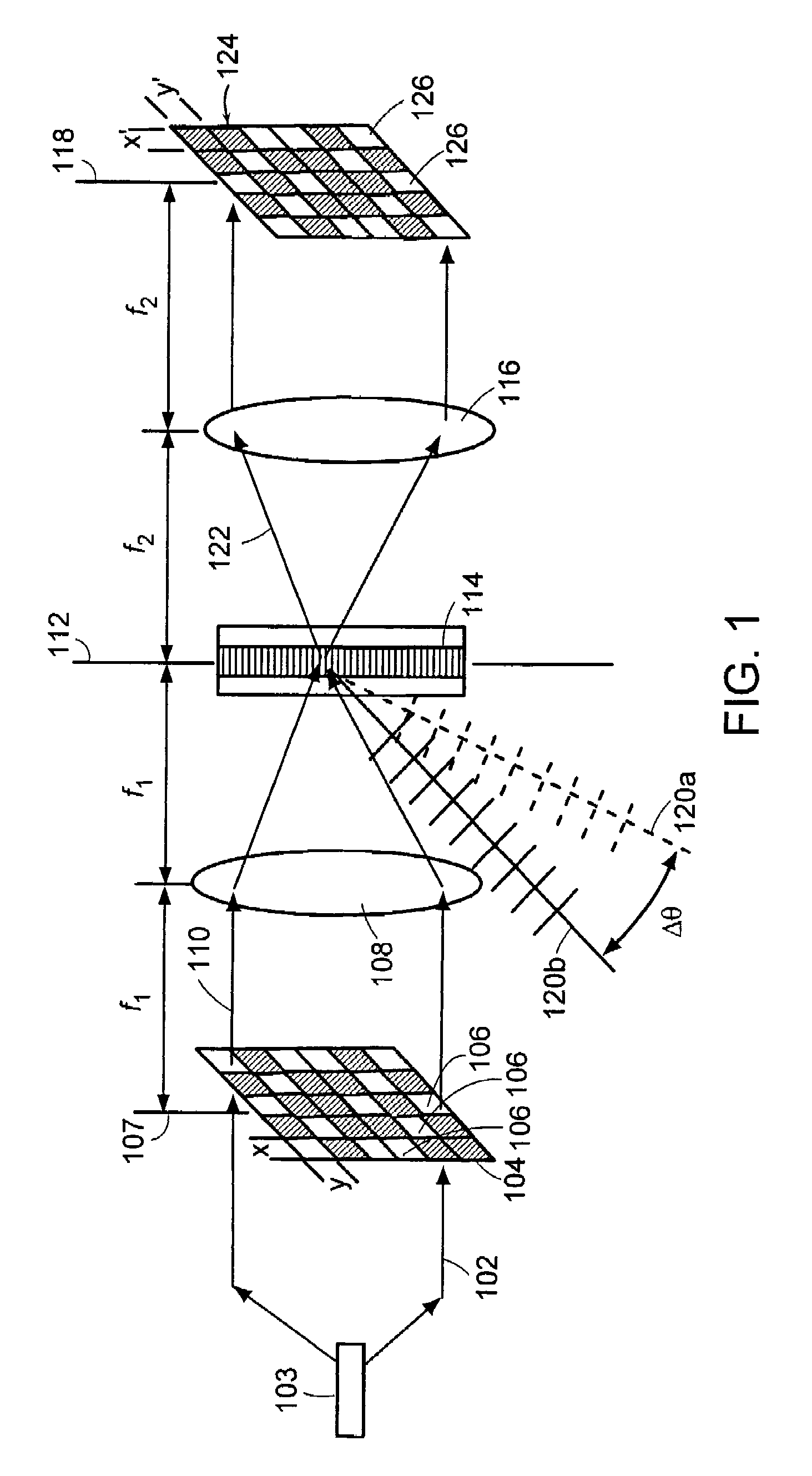Method and apparatus for phase-encoded homogenized Fourier transform holographic data storage and recovery
a fourier transform and holographic data technology, applied in the field of phase-encoded homogenized fourier transform holographic data storage and recovery, can solve the problems of preventing efficient use, significant non-uniform modulation depth of recording, poor fidelity of reconstructed data pages, etc., to reduce the requirements for laser power, improve the fidelity and efficiency of recording, and increase the usable data density
- Summary
- Abstract
- Description
- Claims
- Application Information
AI Technical Summary
Benefits of technology
Problems solved by technology
Method used
Image
Examples
example 1
Recording a Homogenized Phase-Encoded Data Page and Reading the Recorded Hologram Using Edge Enhanced Reconstruction with 4× AND 8× Oversampling at Detector
[0076]Recording was carried out using a Coherent 315M DPSS laser emitting at 532 nm. A classical 4f optical configuration was implemented using spatially filtered coherent reference and signal beams and conventional doublets (f=70 mm) for all optics. Matched power densities were implemented for the signal and reference beams at the recording plane for recording carried out with a Displaytech ferroelectric LCD SLM (1280×768 pixels) in 0-pi phase mask conditions at Fourier Transform plane. The SLM can be operated in binary amplitude (0 and 1) as well as binary phase (0 and π) modes by rotation of the SLM by 22.5 degrees. Alternatively, amplitude and phase mode operations of the SLM were achieved by rotating a half-wave plate kept in front of it. During the binary-phase mode operation the Displaytech SLM, in conjunction with the pol...
example 2
Reconstruction of an Amplitude Data Page by Interference of the Reconstructed Phase-Modulated Data Page and an Imaged Uniform Page Displayed on the SLM
[0079]When the phase hologram is recorded as in Example (1) then reconstruction of the original amplitude data page from the phase image is accomplished by using a real-time holographic interferometric method. In one embodiment, a blank (uniform) page is displayed on the phase SLM. With the object beam being kept ‘ON’, the data page hologram was read-out by concurrent illumination with the reference beam using the correct reference beam angle for said data page hologram. As shown in FIG. 8, interference between the holographically reconstructed data page and the blank (uniform) page from the SLM reproduces the original data page, shown in FIG. 11(a), in amplitude mode for detection by the CMOS camera. The recovered data page as captured by said CMOS camera of Example (1) is shown in FIG. 11(b). FIG. 11(c) shows the phase image as capt...
example 3
Reconstruction of an Amplitude Data Page by Interference of the Reconstructed Phase-Modulated Data Page and a Blank Co-Locationally Recorded Page
[0080]When the phase hologram is recorded so as to use the method of Double exposure holographic interferometry for data recovery, a blank data page (i.e. full field super pixel), in addition to the recording of the phase data page, was carried out near the FT plane. Upon reconstruction with the Reference beam, the presence of the blank page hologram in combination with the phase page hologram provided for an interference of the two resultant diffraction wavefronts thereby providing for reconstruction of the original amplitude data page as shown in FIG. 11(d).
PUM
| Property | Measurement | Unit |
|---|---|---|
| rotation of polarization | aaaaa | aaaaa |
| rotation of polarization | aaaaa | aaaaa |
| angle | aaaaa | aaaaa |
Abstract
Description
Claims
Application Information
 Login to View More
Login to View More - R&D
- Intellectual Property
- Life Sciences
- Materials
- Tech Scout
- Unparalleled Data Quality
- Higher Quality Content
- 60% Fewer Hallucinations
Browse by: Latest US Patents, China's latest patents, Technical Efficacy Thesaurus, Application Domain, Technology Topic, Popular Technical Reports.
© 2025 PatSnap. All rights reserved.Legal|Privacy policy|Modern Slavery Act Transparency Statement|Sitemap|About US| Contact US: help@patsnap.com



